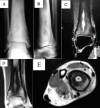Brodie's Abscess of the Ankle Presenting as a Tumor: A Summary of Five Cases
- PMID: 39381291
- PMCID: PMC11458232
- DOI: 10.13107/jocr.2024.v14.i10.4878
Brodie's Abscess of the Ankle Presenting as a Tumor: A Summary of Five Cases
Abstract
Introduction: A Brodie's abscess is a form of subacute osteomyelitis that is often considered in the differential diagnosis of other benign and malignant bone lesions. The authors summarize the findings of five cases of Brodie's abscesses in the distal tibia initially thought to be tumors by the referring physicians.
Case report: All five cases were presented to the referring physicians with a chief complaint of ankle pain. All patients complained of chronic ankle pain and swelling that was aggravated by activity without constitutional symptoms. On physical examination, all patients presented with point tenderness over the distal tibia/malleolar regions. Three out of the five cases had a full range of ankle motion; the other two had limited dorsiflexion secondary to pain. All inflammatory laboratory values were within normal limits or only slightly elevated. All initial radiographs of the cases described demonstrated a well-defined radiolucent lesion within the distal tibia. In all cases, patients were treated with curetting, with or without bone graft. Bacterial and fungal cultures were negative in all five patients and no long-term post-operative antibiotics were administered.
Conclusion: In this report, we discuss the clinical, radiographic, and pathologic features of this relatively rare condition in the distal tibia. The distinct clinicopathologic features of the disease process are presented to distinguish Brodie's abscess from a bone tumor.
Keywords: Brodie’s abscess; Staphylococcus infections; Subacute osteomyelitis; abscess; bone diseases; osteomyelitis; tibia.
Copyright: © Indian Orthopaedic Research Group.
Conflict of interest statement
Conflict of Interest: Nil
Figures




References
-
- King DM, Mayo KM. Subacute hematogenous osteomyelitis. J Bone Joint Surg. 1969;51B:458–63. - PubMed
-
- Boriani S. Brodie's abscess-a study of 181 cases, with special reference to radiographic diagnostic criteria. Ital J Orthop Trauma. 1980;6:373–83. - PubMed
-
- Harris NH, Kirmaldy-Willis WH. Primary subacute pyogenic osteomyelitis. J Bone Joint Surg. 1965;47B:526–32. - PubMed
-
- Stephans MM, MacAuley P. Brodie's abscess-a long term review. Clin Orthop Relat Res. 1987;234:211–6. - PubMed
LinkOut - more resources
Full Text Sources
